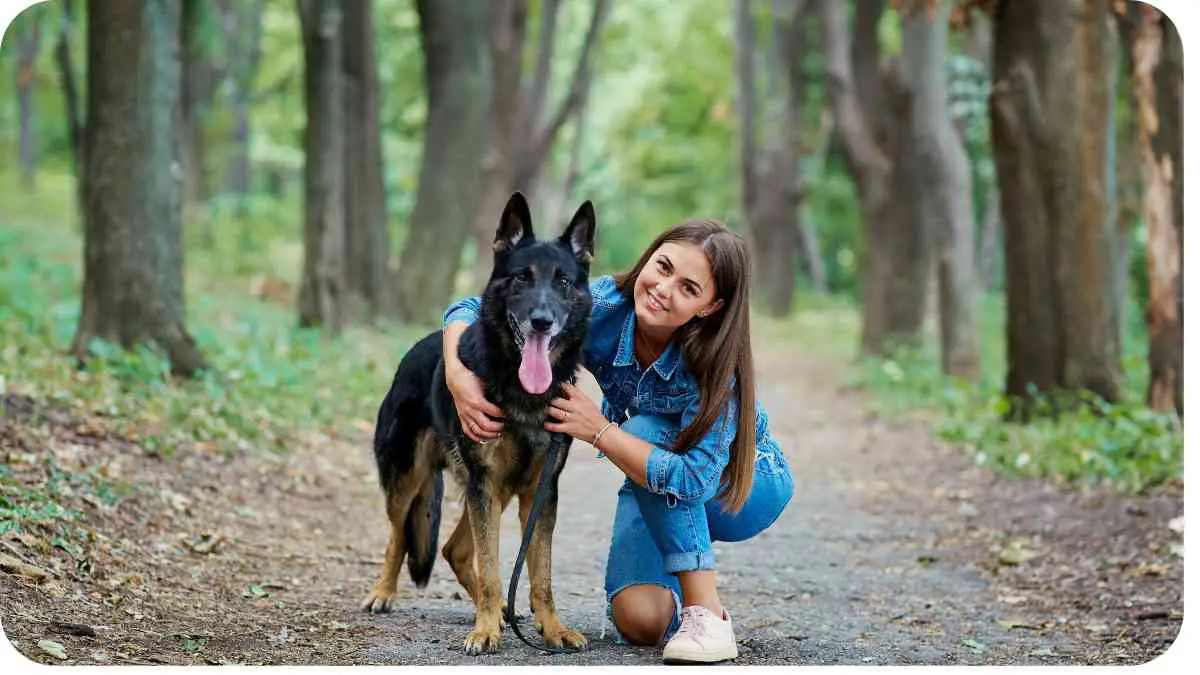The Belgian Shepherd-German Shepherd mix, often affectionately referred to as the “Belgian Malinois Shepherd” or simply “Belgian Malinois,” is a captivating blend of two esteemed herding breeds.
Renowned for their intelligence, loyalty, and versatility, these hybrid dogs make excellent companions for active individuals and families alike. In this comprehensive guide, we’ll delve into the world of Belgian Shepherd-German Shepherd mixes, exploring their characteristics, temperament, health considerations, and more.
| Takeaways |
|---|
| 1. Belgian Shepherd-German Shepherd mixes combine the intelligence, loyalty, and versatility of both parent breeds. |
| 2. These dogs require ample exercise and mental stimulation to thrive, making them ideal companions for active individuals and families. |
| 3. Regular grooming and veterinary care are essential to maintain the health and well-being of Belgian Shepherd-German Shepherd mixes. |
| 4. Positive reinforcement training methods are highly effective for these intelligent and eager-to-please dogs. |
| 5. Early socialization is crucial to ensure Belgian Shepherd-German Shepherd mixes develop into well-adjusted and confident dogs. |
2. Understanding the Belgian Shepherd-German Shepherd Mix
Characteristics of the Belgian Shepherd
| Characteristic | Description |
|---|---|
| Coat Type | Double-coated with a dense undercoat and longer outer coat |
| Temperament | Intelligent, alert, and driven |
| Size | Medium to large, typically weighing 40-75 pounds |
| Energy Level | High energy with a strong work ethic |
| Lifespan | Around 10-14 years |
Characteristics of the German Shepherd
| Characteristic | Description |
|---|---|
| Coat Type | Double-coated with a thick, medium-length outer coat |
| Temperament | Confident, courageous, and loyal |
| Size | Medium to large, typically weighing 50-90 pounds |
| Energy Level | High energy, known for their endurance |
| Lifespan | Typically 9-13 years |
3. Appearance of the Belgian Shepherd-German Shepherd Mix

Coat Colors
The coat colors of Belgian Shepherd-German Shepherd mixes can vary widely, reflecting the diversity of their parent breeds. Common colors include black, fawn, brindle, sable, and combinations thereof. Some may exhibit the distinctive black mask often associated with Belgian Malinois. Additionally, these dogs may inherit the Belgian Shepherd’s characteristic black-tipped hairs, known as “frosting,” adding a unique touch to their appearance.
Understanding the German Shepherd’s lifespan is crucial for responsible pet ownership. According to experts, German Shepherds generally live around 9 to 13 years, but proper care and attention can extend their lifespan.
Size and Build
Belgian Shepherd-German Shepherd mixes typically inherit a sturdy, athletic build from both parent breeds. They are medium to large dogs, with males generally being larger than females. On average, they stand between 22 to 26 inches tall at the shoulder and weigh anywhere from 40 to 90 pounds, depending on factors such as genetics and gender. Their physique is well-balanced, exhibiting both strength and agility, ideal for various activities and tasks.
When considering a new furry family member, it’s essential to know if German Shepherds are suitable for family life. Experts weigh in, highlighting their loyalty, protective instincts, and adaptability, making them excellent companions for households with children.
4. Temperament and Behavior
Intelligence
Both Belgian Shepherds and German Shepherds are renowned for their exceptional intelligence, and their mixed offspring inherit this trait in abundance. Belgian Shepherd-German Shepherd mixes are highly intelligent dogs, possessing keen problem-solving abilities and a sharp instinct for learning new tasks. They thrive on mental stimulation and excel in activities that challenge their intellect, such as obedience training, agility courses, and interactive games.
Trainability
Thanks to their intelligence and eagerness to please, Belgian Shepherd-German Shepherd mixes are highly trainable dogs. They respond well to positive reinforcement techniques, such as praise, treats, and play, making training sessions both effective and enjoyable for both dog and owner. Consistency, patience, and clear communication are key when training these intelligent canines, ensuring they understand what is expected of them and reinforcing desired behaviors consistently.
Energy Levels
The Belgian Shepherd-German Shepherd mix is a breed with abundant energy and a strong work ethic. These dogs thrive in environments where they can engage in regular physical and mental activities to channel their energy constructively. Daily exercise is essential to keep them mentally stimulated and physically fit. Without sufficient stimulation, they may become bored and exhibit undesirable behaviors, such as excessive barking or destructive chewing.
Exercise and Activity Requirements
Given their high energy levels, Belgian Shepherd-German Shepherd mixes require ample opportunities for exercise and activity to keep them happy and healthy. Daily walks, runs, hikes, or play sessions in a secure backyard are essential to fulfill their exercise needs. Engaging in interactive games, such as fetch or agility training, can also provide mental stimulation and strengthen the bond between owner and dog. These activities not only help maintain their physical fitness but also prevent boredom and behavioral issues.
Are German Shepherds a safe and compatible breed for households with kids? Veterinary insights affirm that with proper training and socialization, German Shepherds can form strong bonds with children, displaying gentle and protective behaviors.
5. Grooming Needs

Coat Care
The coat of a Belgian Shepherd-German Shepherd mix requires regular grooming to keep it in optimal condition. Brushing the coat several times a week helps remove loose hair, prevent matting, and distribute natural oils, promoting a healthy shine. During shedding seasons, which typically occur twice a year, more frequent brushing may be necessary to manage shedding and minimize the accumulation of loose hair around the home. Additionally, occasional baths can help keep the coat clean and fresh, but be sure to use a mild dog shampoo to avoid drying out the skin.
Nail Care
Regular nail trimming is essential for maintaining the overall health and comfort of your Belgian Shepherd-German Shepherd mix. Long nails can cause discomfort and even lead to mobility issues if left untrimmed. Aim to trim your dog’s nails every 2-4 weeks, depending on how quickly they grow and how much activity they engage in.
If you’re not comfortable trimming your dog’s nails yourself, consider seeking assistance from a professional groomer or veterinarian to ensure the task is done safely and effectively.
Explore the fascinating heritage of the beloved German Shepherd breed, tracing its roots and evolution from its origins in Germany. Discover how its intelligence, versatility, and working abilities have made it one of the world’s most cherished dog breeds.
6. Health Considerations
Common Health Issues
Like all breeds, Belgian Shepherd-German Shepherd mixes are prone to certain health conditions, some of which may be inherited from their parent breeds. While mixed breed dogs may benefit from genetic diversity, it’s essential for prospective owners to be aware of potential health concerns and take proactive measures to maintain their dog’s well-being. Some common health issues that Belgian Shepherd-German Shepherd mixes may face include:
| Health Issue | Description |
|---|---|
| Hip Dysplasia | A genetic condition where the hip joint develops abnormally, leading to pain and mobility issues. Regular exercise, a balanced diet, and weight management can help reduce the risk. |
| Elbow Dysplasia | Similar to hip dysplasia, elbow dysplasia is a developmental disorder affecting the elbow joint. Proper nutrition, exercise, and avoiding excessive jumping can help mitigate the risk. |
| Bloat | Also known as gastric dilation volvulus (GDV), bloat is a life-threatening condition that occurs when the stomach fills with gas and twists on itself. Feeding smaller, frequent meals and avoiding vigorous exercise after eating can help prevent bloat. |
| Degenerative Myelopathy | A progressive neurological disease that affects the spinal cord, leading to weakness and paralysis. While there is no cure, supportive care and physical therapy can help manage symptoms and improve quality of life. |
| Allergies | Belgian Shepherd-German Shepherd mixes may be prone to allergies, including food allergies and environmental allergies. Identifying and avoiding triggers, along with veterinary guidance, can help manage allergic reactions effectively. |
Lifespan
On average, Belgian Shepherd-German Shepherd mixes have a lifespan of around 10 to 14 years, although individual longevity can vary based on factors such as genetics, diet, exercise, and overall health care. Providing proper nutrition, regular veterinary check-ups, preventive care, and a loving home environment can contribute to extending your dog’s lifespan and ensuring a happy, fulfilling life.
7. Feeding Guidelines
Nutritional Needs
Meeting your Belgian Shepherd-German Shepherd mix’s nutritional needs is essential for supporting their overall health and well-being. These active, energetic dogs require a balanced diet that provides essential nutrients, including protein, carbohydrates, fats, vitamins, and minerals.
Choosing the Right Food
When selecting a dog food for your Belgian Shepherd-German Shepherd mix, opt for high-quality, commercially available dog food formulated specifically for large breeds or active dogs. Look for products that list meat as the primary ingredient and avoid those containing artificial additives, fillers, or by-products. Additionally, consider your dog’s age, size, activity level, and any specific dietary requirements or sensitivities when choosing the most suitable food.
Portion Control
Maintaining an appropriate feeding schedule and portion control is crucial for preventing obesity and promoting optimal health in Belgian Shepherd-German Shepherd mixes. Divide your dog’s daily food allowance into two or three meals to help prevent overeating and aid digestion. Follow the recommended feeding guidelines provided by the dog food manufacturer, but adjust portion sizes as needed based on your dog’s individual metabolism, activity level, and weight management goals.
Gain valuable insights into why German Shepherds may exhibit biting behavior and how to address it effectively. Understanding training techniques and building trust are essential for fostering a harmonious relationship between owners and their German Shepherd companions.
8. Training Tips
Positive Reinforcement
When training a Belgian Shepherd-German Shepherd mix, positive reinforcement techniques are highly effective due to their intelligence and eagerness to please. Use rewards such as treats, praise, and play to reinforce desired behaviors and encourage learning. Avoid punishment-based methods, as they can erode trust and hinder the training process. Instead, focus on positive interactions that motivate and engage your dog, making training sessions enjoyable for both of you.
Consistency and Patience
Consistency is key when training a Belgian Shepherd-German Shepherd mix. Establish clear rules and expectations from the beginning, and consistently reinforce desired behaviors while gently redirecting or correcting unwanted behaviors. Be patient and understanding, as every dog learns at their own pace. Celebrate small victories and progress, and don’t get discouraged by setbacks. With patience, consistency, and positive reinforcement, your dog will continue to learn and thrive.
Socialization
Early and ongoing socialization is vital for Belgian Shepherd-German Shepherd mixes to ensure they grow into well-adjusted, confident dogs. Expose your puppy to a variety of people, animals, environments, and experiences from a young age to help prevent fearfulness or aggression later in life. Enroll your dog in puppy classes or obedience training classes where they can interact with other dogs and people in a controlled environment. Regular outings to dog-friendly parks, pet stores, and social gatherings can also provide valuable socialization opportunities.
9. Socialization Needs
Interaction with People
Belgian Shepherd-German Shepherd mixes are known for their strong bond with their family members and their innate desire to please. They thrive on companionship and enjoy spending time with their human pack members.
Encourage positive interactions with people of all ages, including children, to help reinforce their friendly and sociable nature. Supervise interactions with young children to ensure they are gentle and respectful towards the dog, and teach children how to properly interact with and handle the dog safely.
Interaction with Other Dogs
Proper socialization with other dogs is essential for Belgian Shepherd-German Shepherd mixes to develop appropriate social skills and prevent aggression or fearfulness towards other dogs.
Arrange playdates with friendly, well-behaved dogs of similar size and energy level to provide opportunities for positive social interactions. Monitor play sessions closely and intervene if necessary to prevent rough play or conflicts. Encourage calm, polite greetings and interactions, and reward your dog for displaying appropriate behavior around other dogs.
10. Finding a Belgian Shepherd-German Shepherd Mix

Adoption
Consider adopting a Belgian Shepherd-German Shepherd mix from a local animal shelter or rescue organization. Many mixed breed dogs, including Belgian Shepherd-German Shepherd mixes, are in need of loving homes and can make wonderful companions. Visit shelters, attend adoption events, and browse online adoption websites to find available dogs in your area. Adoption not only provides a loving home for a dog in need but also offers the opportunity to give a second chance to a deserving animal.
Breeders
If you decide to purchase a Belgian Shepherd-German Shepherd mix from a breeder, it’s essential to research reputable breeders who prioritize the health and well-being of their dogs. Look for breeders who conduct health screenings on their breeding dogs to identify and minimize the risk of inherited health conditions. Visit the breeder’s facility in person to meet the parent dogs and observe their living conditions. Ask plenty of questions about the breeder’s breeding practices, socialization efforts, and health guarantees for puppies.
11. Conclusion
In conclusion, the Belgian Shepherd-German Shepherd mix is a captivating and versatile breed that combines the best qualities of its parent breeds. With their intelligence, loyalty, and energetic nature, these dogs excel in various roles, from devoted family pets to working dogs in search and rescue, police work, and more.
By understanding their unique characteristics, temperament, and care needs, prospective owners can provide the ideal environment for Belgian Shepherd-German Shepherd mixes to thrive and lead fulfilling lives. Whether adopted from a shelter or purchased from a reputable breeder, these remarkable dogs have much to offer to dedicated owners willing to provide them with love, training, and companionship.
Thank you for joining us on this journey to unravel the world of the Belgian Shepherd-German Shepherd mix. May your adventures with your furry companion be filled with joy, companionship, and endless wagging tails.
Further Reading
- Working Shepherds Blog: Explore more about Malinois, Dutch Shepherd, and German Shepherd crosses and mixes in this comprehensive blog post.
- Camelot Shepherds: Learn about the Shepinois, a cross between a German Shepherd and a Belgian Malinois, on the Camelot Shepherds website.
- Vetic Blog: Delve into the brilliance of Belgian breeds and unravel the differences between the Belgian Shepherd and Belgian Malinois on the Vetic Blog.
FAQs
What are the main characteristics of Belgian Shepherd-German Shepherd mixes?
Belgian Shepherd-German Shepherd mixes typically inherit traits such as intelligence, loyalty, and high energy levels from their parent breeds. They are known for their versatility and excel in various roles, including as family pets, working dogs, and companions for active individuals.
Are Belgian Shepherd-German Shepherd mixes suitable for families with children?
Yes, Belgian Shepherd-German Shepherd mixes can be excellent family pets, especially in households with older children who understand how to interact with dogs respectfully. Early socialization and training are essential to ensure they develop appropriate behavior around children and other family members.
What are the grooming requirements for Belgian Shepherd-German Shepherd mixes?
Belgian Shepherd-German Shepherd mixes have medium to long coats that require regular brushing to remove loose hair and prevent matting. They shed moderately year-round and may experience heavier shedding during seasonal changes. Additionally, they require periodic baths and nail trimming to maintain their overall hygiene and health.
Do Belgian Shepherd-German Shepherd mixes have any specific health concerns?
Like all breeds, Belgian Shepherd-German Shepherd mixes may be prone to certain health issues, including hip dysplasia, elbow dysplasia, bloat, and allergies. It’s essential for owners to be aware of these potential health concerns and take proactive measures to maintain their dog’s well-being through proper nutrition, exercise, veterinary care, and preventive measures.
How much exercise do Belgian Shepherd-German Shepherd mixes require?
Belgian Shepherd-German Shepherd mixes are energetic dogs that require plenty of physical and mental stimulation to stay happy and healthy. They benefit from daily exercise, including brisk walks, runs, hikes, and interactive play sessions. Engaging in activities such as agility training, obedience training, and scent work can also help satisfy their need for mental stimulation and prevent boredom.

I’m Dr. Hellen James, I’ve spent my career working with dogs, and I’ve seen first-hand how important it is to understand the individual needs of each breed. I want to share my knowledge of dog breeds with you so that you can make informed decisions about which dog will be best for your household and lifestyle.

